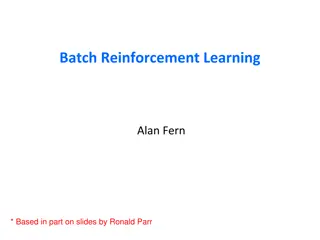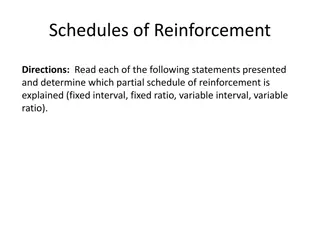Theories of Reinforcement in Behavioral Economics
Explore key theories of reinforcement including Thorndike's Law of Effect, Hull's Drive Reduction Theory, the Premack Principle, Response-Deprivation Hypothesis, and Behavioral Economics concepts such as Response Allocation. Learn about reinforcers as stimuli, primary and secondary reinforcers, the Premack Principle, and the Response-Deprivation Hypothesis. Discover how behavioral adjustments to schedule constraints and the elasticity of demand impact response allocation. Understand that reinforcers are not special stimuli, instrumental conditioning constrains behavior, and reinforcement effects lead to response reallocation in a process of optimization.
Download Presentation

Please find below an Image/Link to download the presentation.
The content on the website is provided AS IS for your information and personal use only. It may not be sold, licensed, or shared on other websites without obtaining consent from the author.If you encounter any issues during the download, it is possible that the publisher has removed the file from their server.
You are allowed to download the files provided on this website for personal or commercial use, subject to the condition that they are used lawfully. All files are the property of their respective owners.
The content on the website is provided AS IS for your information and personal use only. It may not be sold, licensed, or shared on other websites without obtaining consent from the author.
E N D
Presentation Transcript
Chapter 9 Theories of Reinforcement Thorndike and the Law of Effect Hull and Drive Reduction Theory The Premack Principle The Response-Deprivation Hypothesis Response Allocation and Behavioral Economics
Reinforcers as Stimuli Primary reinforcers and biological drives Secondary reinforcers and acquired drives Sensory reinforcers
The Premack Principle Reinforcers as responses Differential Probability: A high(er) probability response will reinforcer a lowe(er) probability response
The Response-Deprivation Hypothesis Restricting access to an activity below its baseline rate makes that response a reinforcer. Instrumental conditioning procedures typically involve restricting access to the reinforcer response. Reinforcers are created by the restrictions inherent in an instrumental conditioning procedure.
Response Allocation & Behavioral Economics Individuals have a behavioral bliss point. The bliss point is defended in the face of constraints on response options. An instrumental contingency constrains response options and causes deviation from the bliss point. Adjustments to the constraint determine whether a response shows (or does not show) a reinforcement effect. Behavioral adjustments to schedule constraints are a function of the elasticity of demand and the availability of substitutes for the reinforcer activity.
Key Concepts in Response Allocation Reinforcers not special kinds of stimuli. Instrumental conditioning is a constraint on the free flow of behavior. Reinforcement effects represent response reallocation, not the strengthening behavior. Effects of a particular instrumental contingency depend on all behavioral options. Response reallocation involves a process of optimization characterized by economic concepts.























